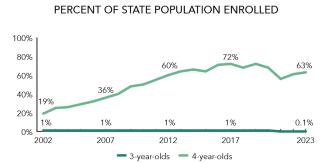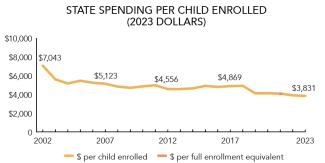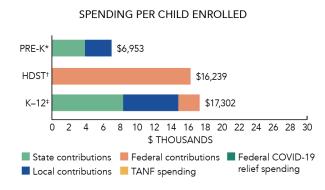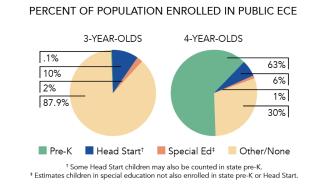
State of Preschool
Wisconsin
Access Rankings
Resource Rankings
Total Benchmarks Met
Overview

During the 2022-2023 school year, Wisconsin preschool enrolled 44,901 children, a decrease of 845 from the prior year. State spending totaled $171,994,862, down $5,838,754 (3%), adjusted for inflation, since last year. State spending per child equaled $3,831 in 2022-2023, down $57 from 2021-2022, adjusted for inflation. State spending per child is an average; funding for Wisconsin Four- Year-Old Kindergarten (4K) is based on a formula that results in varying spending amounts per child. Wisconsin met 2 of 10 quality standards benchmarks.
Background

Since becoming a state in 1848, Wisconsin’s Constitution has included a promise to provide free, voluntary education for 4-year-olds. School districts are not required to offer a 4K program, but if they do, it must be open to all age-eligible children within the school district.
Funding for 4K is part of the overall school funding formula. For state aid purposes, 4K students are counted as either .5 or .6 full time equivalent (FTE), depending on the services the school provides. Districts provide either 437 hours of instruction or 349.5 hours of instruction and 87.5 hours of family outreach (for .5 FTE membership aid) or 437 hours of instruction and 87.5 hours of family outreach (for .6 FTE membership aid). Funds for 4K are distributed to public schools, which may subcontract and collaborate with community providers per guidance of public education funding and state requirements. Operating schedules are locally determined with most programs operating part-day, four or five days per week and some operating full-day, two or three days per week.
The Wisconsin Head Start State Supplement Grant is a separate budgetary item that offers state funding, via an application, to federal Head Start grantees in Wisconsin. Funding is used to supplement the provision of comprehensive early childhood education services for children and families enrolled in Early Head Start and Head Start. Awarded grantees continue to follow the federal Head Start Performance Standards. Ongoing collaborative efforts bring together Head Start technical assistance and training with other professional development efforts at both the state and local levels. The Wisconsin Head Start State Supplement Grant data is no longer included in this report beginning with the 2020-2021 school year since supplemental funds do not substantially expand the number of children served.
Wisconsin Four-Year-Old Kindergarten (4K)
Access
Resources
| Total state pre-K spending | $171,994,862 |
| Local match required? | No |
| State Head Start spending | $6,264,100 |
| State spending per child enrolled | $3,831 |
| All reported spending per child enrolled* | $6,953 |

*Pre-K programs may receive additional funds from federal or local sources that are not included in this figure. †Head Start per-child spending includes funding only for 3- and 4-year-olds. ‡K–12 expenditures include capital spending as well as current operating expenditures.
Wisconsin Quality Standards Checklist
| Policy | Requirement | Benchmark | Meets Benchmark? |
|---|---|---|---|
For more information about the benchmarks, see the Executive Summary and the Roadmap to State pages. | 2benchmarks met | ||
| Early Learning & Development Standards Benchmark | Comprehensive, aligned with some other state standards, supported, culturally sensitive | Comprehensive, aligned, supported, culturally sensitive | |
| Curriculum Supports Benchmark | Approval process & supports | Approval process & supports | |
| Teacher Degree Benchmark | BA | BA | |
| Teacher Specialized Training Benchmark | B-3, K-9 | Specializing in pre-K | |
| Assistant Teacher Degree Benchmark | HSD (public); Other (nonpublic) | CDA or equivalent | |
| Staff Professional Development Benchmark | PD plans (public teachers); Coaching (some nonpublic) | For teachers & assistants: At least 15 hours/year; individual PD plans; coaching | |
| Maximum Class Size Benchmark | Determined locally (3- & 4-year-olds) | 20 or lower | |
| Staff to Child Ratio Benchmark | Determined locally (3- & 4-year-olds) | 1:10 or better | |
| Screening & Referral Benchmark | Vision & immunizations | Vision, hearing & health screenings; & referral | |
| Continuous Quality Improvement System Benchmark | Structured classroom observations determined locally; Data used for program improvement at local level only | Structured classroom observations; data used for program improvement | |
